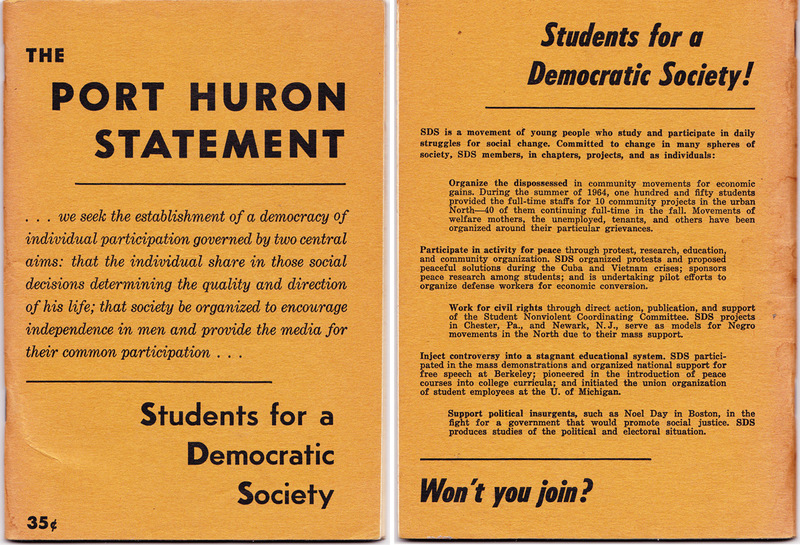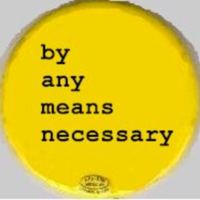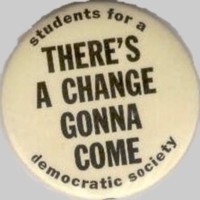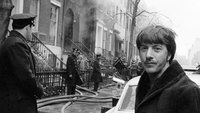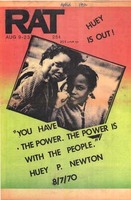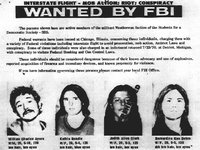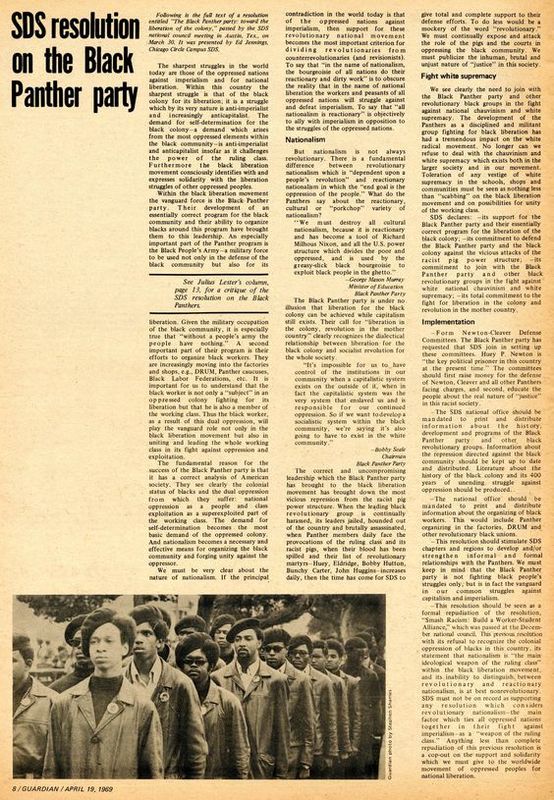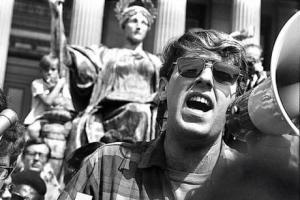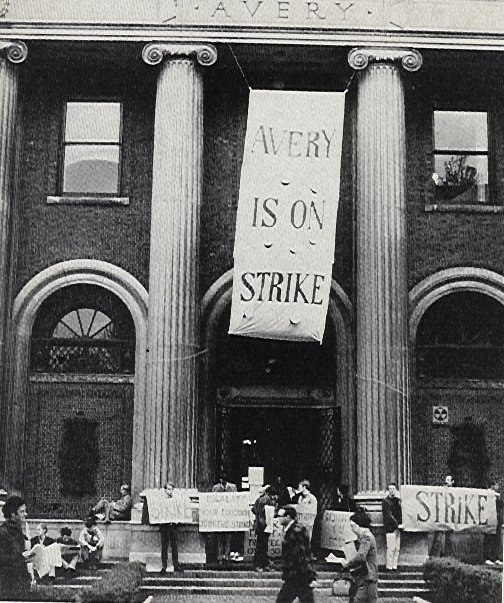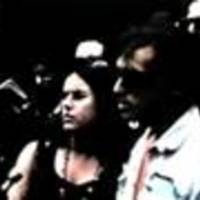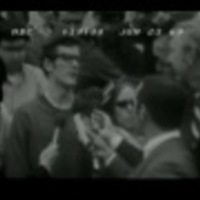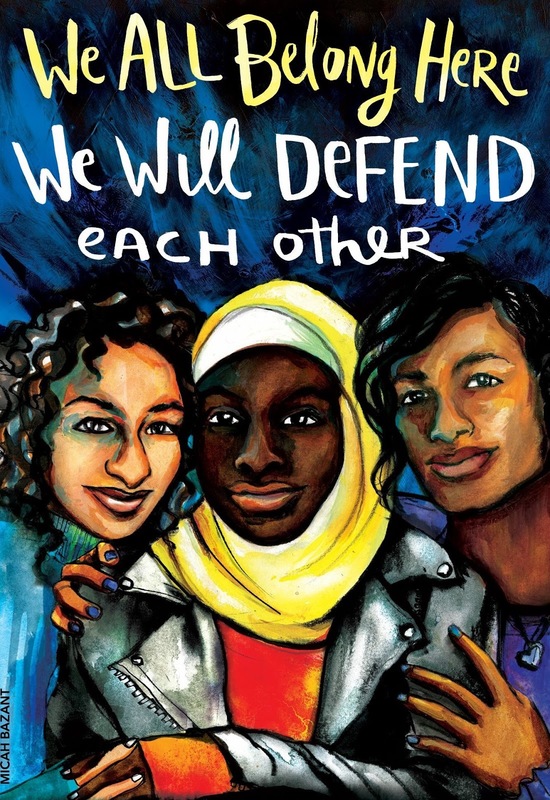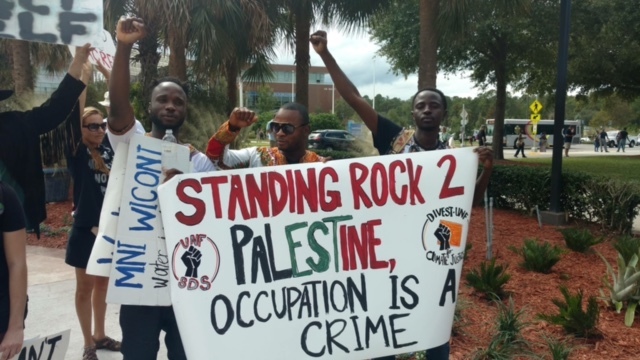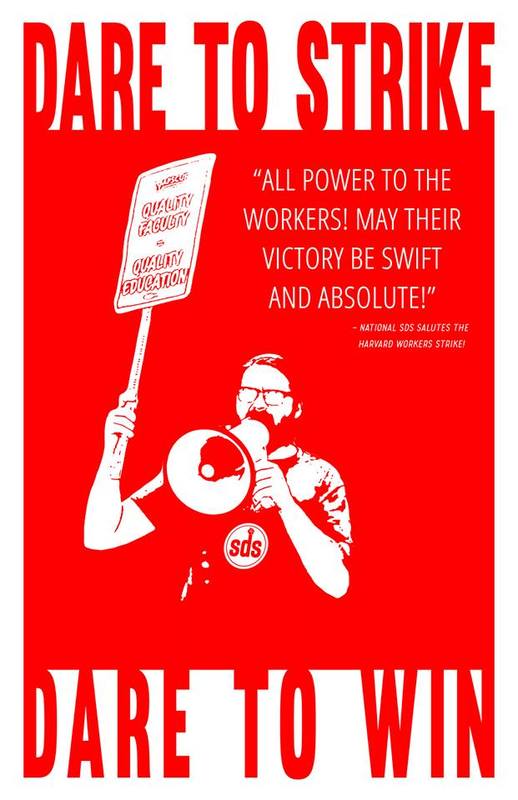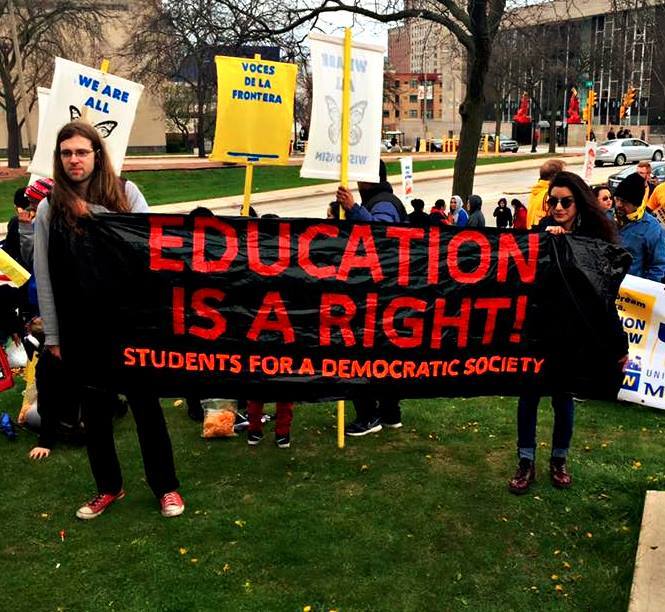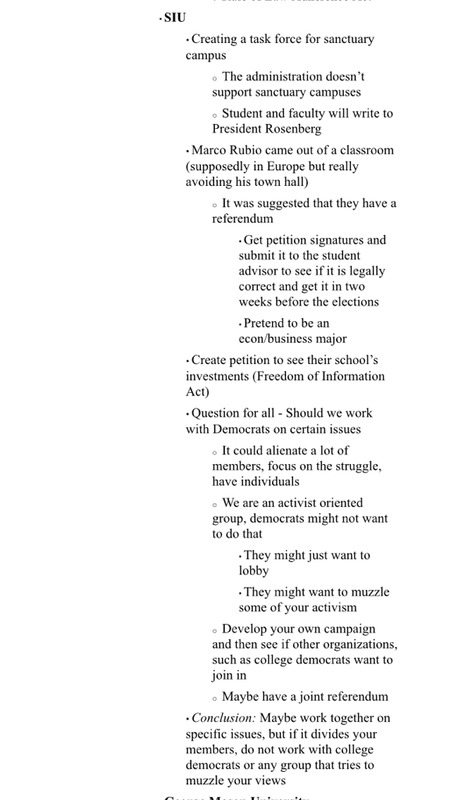Students for a Democratic Society
This is a digital history exhibit on the Students for a Democratic Society (SDS) created by Chloe Ammons, Rachel Hunt, Shalaundye Felton, and Anna Roberts for History 4120 (History of the Civil Rights Movement).
SDS was a radical leftist student organization that began in the United States in the mid-1960s and was active until 1969. SDS advocated for student power through direct action and actively criticized the United States' involvment in the Vietnam war.
Port Huron Statement & Ideology
The Students for a Democratic Society was a leftist student movement that came out of the early 60s in the midst of the New Left, and had chapters and wide participation throughout America in the 60s, most notably the anti-war and free speech movement. The New Left mainly referred to the student movement that came about in the 1960s that focused on social injustices throughout the United States. They were heavily concerned with the “establishment” of the country and wanted to change the government with (in the very least) a social revolution, though many groups were even more radical. The SDS could be considered the flagship organization of the New Left. They branched off of the Student League for Industrial Democracy or SLID because they believed the organization’s ideologies were too restricting. Hence the SDS was very vague in their principles, so to appeal to a wide group of students with varying ideologies. This can be seen in their most important document, which describes them as an organization and can lead to a better understanding of them as a group, “The Port Huron Statement.”
"The Port Huron Statement" was the manifesto of the Students for the Democratic Society. Tom Hayden, a leader of the original SDS, as well as a student at University of Michigan was the working force behind the document. Tom Hayden along with other founding members came together in Port Huron, Michigan, in the June of 1962 to lay out the ideologies and goals of their new organization, which heavily reflected that of the New Left. The first part of the document brings understanding to their viewpoint of society and American political and military actions, while the second half focuses on how America should "establish greater democracy in America" (46), and tactics their organization could use to help the United States achieve this. To give a clear understanding of the SDS ideology and goals "The Port Huron Statement" is an important document to study as it outlined their beliefs and goals.
INTRODUCTION: AGENDA FOR A GENERATION
In the introduction to the SDS’ “The Port Huron Statement,” the authors examine their history and the modern era’s effect of the conscious. Children of the post-World War II era grew up perceiving America as a great prosperous nation, but with age these children examined the United States and came to a different understanding. The Civil Rights movement of the late 50’s and 60’s showed the “permeating and victimizing fact of human degradation” (3) that came with racism, practically displayed in the southern states. The people of this era lived under the “the Bomb” and the threat of a nuclear war, due to America’s foreign policies against communism. The 1950’s and 60’s brought a time of revolution against European imperialism, as well as “the entrenchment of totalitarian states, the menace of war, overpopulation, international disorder, (and) supertechnology” (4). This new era inspires the SDS to strive for “democracy and freedom” to bring utopia to a world of chaos and destruction. They are committed to making a better future through experimentation through democracy and social equality.
VALUES
The SDS recognized that past socialist movements do not fit their modern era, and that it is recognized that their "liberal and socialist predecessors were plagued by vision without program, while our own generation is plagued by program without vision" (5). The SDS wanted to encourage people to study and come to different conclusions about the way society and the state is run, as well as appreciate efforts to do this. The SDS believed that modern society didn’t respect the search for "utopia" and in fact considered is naive and childish. The SDS wanted to discourage this idea and believed that men have the capacity to learn and live with "reason, freedom, and love" (6). There were four basic principles the Students for a Democratic Society used to define their idea of democracy. They believed that decisions should be made within the state that effect society and the community should be made publically and not within a secretive governmental office, without any say given to the people. The SDS demanded that politics’ main purpose should be used to advance society and equality and should be used to positive social effects. They also believed that politics should be a way to unify people, and bring meaning to an individual’s life through political participation. Lastly the SDS believed that “political order should serve to clarify problems in a way instrumental to their solution (8).
The SDS believed that work should be more meaningful to the worker’s life and should involve "incentives worthier than money or survival" (8). They believed that there should be democratic participation from the masses in the means of production as well as having the means of production regulated by the people. Students for a Democratic Society believed that social institutions, "should be generally organized with the well-being and dignity of man as the essential measure of success" (8), as well as that violence should not be tolerated and should be abolished in all levels of the state.
THE STUDENTS
The SDS was a lead organization in the student protest movement, so naturally they examined the institution that brought them together, the university, as well as their role as students. They came to the conclusion that the university system prepared students to be future citizens of the United States. These students didn’t really learn in college, instead they were trained to be tools of the state. The university crushed free thinking “through emasculation of what creative spirit there is in the individual" (10). Though while the education the university supplied the student may have made that person more understanding and “tolerant” than they were before, in all going to school left young people “unchallenged in their values and political orientations” (11).
TOWARDS AMERICAN DEMOCRACY
The Students for a Democratic Society introduced a six step plan on how they believed a true American democracy could be achieved. First they believed that America was in a “political party stalemate.” Due to the southern democrats or “dixiecrats” the Democratic Party was split. Their existence within the party made the democrats as a whole more conservative. This led to an ideological overlap between the major American political parties. This caused “congressional listlessness” making it hard to achieve change through governmental processes, so for a true democracy to function there must be two distinct political parties, giving the American people a real choice. Second the SDS believed that there should be organizations created through the government that would pass along information as well as inspire participation in politics. These organizations should be set up around "single issues," their examples were public transportation, medical care, and groups for laborers and minorities. Third, the SDS believed that the government should promote Freedom of Speech. They thought that the government felt threatened by freedom in "speech, assembly, thought, religion, and press" (47). Students for a Democratic Society demanded that the government promote freedom of speech. This would bring about a more educated public, leading to a society driven less be fear and prejudice. Fourth, the SDS wanted to confront the corporations that hold power in the state and promote political, as well as "economic realignments" within the U.S. government. This would bring more power to the people in the government, taking it away from the wealthy, for “true democracy” could not exist when control of a state was in the hands of a small group of the wealthiest persons and not within the hands of the common people. The best way to do this is to hold corporations responsible for their own actions. Fifth, the resources of the states shouldn’t be kept in the hands of the powerful, but instead should be placed within the “public sector” and reallocated based on the needs of the people. The U.S. needed to separate itself from its "permanent war economy," which had been in place since World War II and NATO. The SDS promoted government participation within the economy and the enlargement of the public sector, to promote a high employment rate, and a thriving economy. The SDS suggests to do this in multiple ways, when new resources were discovered they believed that it should remain a public resource. If there was a monopoly in a certain industry, the public should have control of it instead of an individual. If there was a situation, where there is a choice between the public of business, the public should always be chosen. And last, the SDS wanted the United States to “concentrate on its genuine social priorities: abolish squalor, terminate neglect, and establish an environment for people to live in with dignity and creativeness" (50). They wanted a program to be introduced to end poverty by changing the social circumstances that promote it. This should have included housing, medical care, Social Security for everyone on a sliding scale benefiting the poor most, as well as a $1.50 minimum wage. There should have been a "public initiative" to promote civil rights. This civil rights initiative should have been led by the legislative and federal government, an example of this would be enforcing laws on desegregation and voting, as well as introducing laws on "economic protection." The government should have also focused on prisons, mental health institutions, education, agricultural policies, and science.
THE UNIVERSITY AND SOCIAL CHANGE
The University is the center of American education, what the university taught could have changed society. It also is the center for "organizing, evaluating, and transmitting knowledge" (61). The resources of a university such as scholarly writings could have been used to educate the masses and bring about a change in the social conscience. Any form of education and knowledge would have been helpful to society, making the university a crucial part of the student movement.
The Weather Underground
Beginnings:
SDS found itsself in the midst of ideological conflicts and power struggles during their 1969 Chicago convention. The Weathermen, or the Weather Underground, was founded out of these clashes of ideology in an attempt to take more militant action against the United States government and their involvement in the war in Vietnam. The faction of the SDS was founded at the University of Michigan campus in 1969 and argued that peaceful protest was getting revolutionaries nowhere and that violence was needed to truly ignite change.
The Weathermen took their name from a Bob Dylan lyric "You don't need need a weatherman to know which way the wind blows." The group members took this lyric as meaning that "anyone could see a world revolution was imminent." The group advocated for militant action and violence in order to destroy U.S imperialism and capitalism while working towards a classless world and global communism.
Actions of the group:
The Weather Underground began as a separate faction from SDS, advocating for a complete overthrow of the U.S. government in opposition to the Vietnam war. The members of the Weather Underground sought to militarize young, white people to fight for social justice for underrepresented and oppressed groups. The Weathermen aligned themselves with the Black Panther group, calling for overt violence and resistance. Their most noteworthy actions began with the organized protests in Chicago that came to be known as the “Days of Rage.” Eight hundred protesters faced some 2,000 police officers in Chicago from October 8-11 1969, with 287 Weathermen being arrested. The protests involved direct action, including vandalizing businesses, homes and cars along with brutalizing and assaulting police officers.
Following the events of the Days of Rage, the Black Panthers began retracting support of the Weather Underground and disassociating with the group. However, the groups were still supportive and sympathetic with the Black Panthers and began to become more violent after the police killing of member Fred Hampton, who had once supported the group. Following the police killing of Hampton in 1970 the members of the Weather Underground declared a State of War against the United States and began planning an elaborate bombing throughout the country.
The bombing campaign began with disaster as a stick of dynamite prematurely exploded in a Weather Underground safe house in Greenwich Village, killing three members and injuring two more. The bomb was meant to be detonated at a non-commissioned officers dance at Fort Nix, along with some reports stating that another was to be detonated at a Columbia University library. Following the explosion the members of the Weather Underground officially went underground to avoid police capture, but continued to carry out the campaign. The Weathermen argued that they needed to "bring the war home" by showing American citizens the type of violence that was taking place in Vietnam. By the end of their bombing campaign the Weather Underground had taken credit for 25 bombings, including bombings of the U.S. Capitol and the Pentagon, claiming that not a single death resulted from any of them.
Dissolution of the Weather Underground:
The Weather Underground was steadily declining after 1976 and became essentially defunct by the early 1980s. Following a convention in 1976, the group split again into two conflicting assemblies, the May 19th Communisti Convention and the Prairie Fire Organization. Most influential members of the group avoided prosecution by proving that the federal government had used illegal methods in their investigation of the group. The Prairie Fire Organization continues to exist today but now advocates for direct action through nonviolent means.
Criticism of SDS
Students for a Democratic Society attempted to lead a non-ideological student movement that focused on issues of race, foreign policy and economic inequality. Unfortunately, it had too many ideas and ideologies confined within such a small group, that ultimately led to their demise. There was no clear end goal, and there was no actual method implemented in obtaining the desires the group had. Hal Draper, socialist activist and author said, "This was the explosiveness of uncalculated indignation, not the slow boil of planned revolt... the first discovery of the chasm between rhetoric of ideals and the cynicism of power among the pillars of the society."
SDS politics arose during a time of tension and crisis within American society. America was in the middle of the Cold War, and was enduring threats of communism. America was fighting for democracy abroad, in Vietnam, but was still facing issues of racism and economic inequality at home. SDS went through extreme rapid changes. “SDS politics went through a very rapid evolution to the left, from liberal protest in 1964, to anti-imperialist resistance in 1967, to varieties of anti-capitalist revolutionism today [1969]." Again, it was never clear where SDS stood, for different sectors within the group wanted different things. While initially, SDS was well-intentioned, it quickly turned serious. Its attempt to save the world was becoming violent and radical.
Many individuals felt this party was a group of young adults with no particular cause. SDS was made up primarily of young, white, college-educated individuals and this was one aspect that was oftentimes criticized. SDS wanted to bring liberation to the world, but yet lived in the suburbs and with parents who were making liberation difficult for the black and brown communities within the U.S. Some felt SDS had nothing to fight for, that they were simply privileged white kids who wanted to be a part of the movement.
Black Panther Party
Initially, SDS attempted to gather a multitude of activist groups in order to "fight the good fight," and to "bring the war home." It worked with the Black Panther Party to focus on liberation movements throughout the world. However, the Black Panther Party quickly became a critic of SDS. The Black Panther Party felt that SDS was a fascist organization. This in part came from SDS' refusal to endorse "all aspects of a nationwide petition campaign for community control of local police initiated by the Panthers." SDS did not want to implement control within the white society, for fear of leading to white supremacy. The Black Panther Party felt one could not pick and choose where liberation should be. David Hilliard, of the Black Panther Party, stated, "My attitude, and I think that I share the unity of concept and will with the Party, is SDS is dizzy from success. That they have asserted the right for the revolutionary vanguard of the oppressor country. But the Black Panther party hasn’t endorsed that. We don’t see SDS as being so revolutionary. We see SDS as just being another pacification front that’s given credit by the fascist establishment in order to cause diffusion in hopes that this would weaken the support for the Black Panther party. . . . SDS had better get their politics straight because the Black Panther party is drawing some very clear lines between friends and enemies. And that we’re going to make it very clear that we’re not going to be attacked from any of those motherfuckers.”
Peak of the Movement- What Happened?
At its peak, SDS had grown to become a national movement against the United States’ involvement in the Vietnam War. In a little over two years since it start, Students for Democratic Society had grown to be an organization with 40 chapters at different colleges across the nation. SDS had managed to mobilize and organize strikes at college campuses across the nation in protest of the war. Members of the organization were vehemently opposed to the US’s involvement in the war and the implementation of drafts, and were eager to join in on the anti-war movement. Many members credit the Vietnam anti-war movement roots with the previous efforts of the civil rights movement, women’s movement, and past student movements in the Cold War. The image of the US to the world and its citizens was not so great during this time. Furthermore, with the implementation of the Tet Offensive, everyone was exposed to how badly the war was.
Hundreds of protests were organized all over the nation. According to Tom Hayden, these took place over the span of ten years (1965-1975). Many social organizations from across the nation joined in on the efforts to promote peace and end the war. In regards to SDS, protests started small with vocal opposition and "teach ins". Teach-ins were basically small lectures where people talked about current issues of interest. These became very popular during this time, with the first teach-in being held at the University of Michigan. As the US involvement in Vietnam increased, so did the SDS anti-war efforts. Students began to stage entire days- and even weeks- of resistance to express their grievances. These protests usually consisted of groups occupying multiple buildings on their respective campuses until their needs were addressed.
In April of 1968, the Columbia University chapter of SDS (the organization’s 52nd chapter) and other student organizations on the campus decided to occupy many of the campus’s buildings in protest of their involvement with IDA (Institute for Defense Analyses), a war weaponry research company. This was not the chapter’s first protest of the school administration. They had protested before over the college allowing war recruitment on the campus (ROTC, Marine Corps, etc). The protest lasted 8 days before ending with the NYPD forcibly removing the students from the occupied spaces. The protest was peaceful and nonviolent, but after a week of no resolution between the administration and students, the administration decided that this was the best way to keep the protest from escalating.
After the strike, the university tried to move on from the event, however, SDS remained relatively active throughout that school year.
Even though the Vietnam War was a big issue for the group nationwide, many different sections and chapters began to turn their efforts to other issues such as racial injustices in America and injustices in other countries. For example, the members of the San Francisco State chapter were among the major campus leaders of the third world liberation student strike, that ultimately led to minority organizations being created on college campuses nationwide. This strike has been known as the longest student strike in US history.
Despite its rapid growth and relative success since its beginnings, SDS would not be able to withstand the test of time. Being a national movement, there was bound to be a difference in ideas among the organizations. Those differences became very evident at the 1969 Students for Democratic Society Convention in Chicago. In the years prior, the differences and ideals and focuses caused a strain on the organization. Some of the members felt as if the peaceful, nonviolent tactics that SDS advocates was not producing any great results. A more militant approach suited them best. SDS was facing an internal power struggle that ultimately led to their demise at the convention.
There were three major sub groups of SDS at the convention: Progressive Labor Party, Revolutionary Youth Movement (Weather Underground/ RYM), and the Independent Socialist Club. The Progressive Labor (PL) party was a faction of SDS members with Marxist ideals for the group, while the Revolutionary Youth Movement was a more anti-government and anti-war militant faction of SDS. PL wanted the organization to focus more on the working class and did not like that the white members were the face of the revolutionary movement. RYM wanted SDS to lend a more helping hand to other revolutionary movements at the time. The Black Panther Party was one of the groups that the RYM stood behind. Because of their opposing, viewpoint, PL and RYM quickly became at odds with each other’s groups, before the convention even occurred. When the convention finally started, tensions were at an all time high. All the members of SDS who attended came with high hopes for the success of the event. However things quickly turned bad when the many factions began discussing their views and grievances. According to former RYM member, Mark Rudd, a huge verbal disagreement between PL, RYM, and the Black Panther Party during the convention ended in the RYM walking out, splitting up the SDS organization.
According to Rudd, a member of the Black Panther Party began to speak at the convention. When the Panther began to attack “armchair Marxism” and began to advocate for women’s liberation, referring to it as “PUSSY POWER”. The PL members did not like that statement so they started shouting and accusing the BPP of being chauvinists, which resulted in SDS and others responding with “Stop racism” chants. After the exchange, members of the BPP demanded that the SDS organization distance themselves from the PL party because of their “racist” ideals. Ultimately, the members of the RYM faction walked out of the convention, solidifying the split of the organization.
New Students for a Democratic Society
In the section below I interviewed a friend of a friend who was heavily involved in the New SDS to give insight into the revival of the organization as well as to connect history to the present. The New Students for a Democratic Society was formed in 2006, taking their name and inspiration from the original organization. As stated on their website, the organization means to learn "from the successes as well as the mistakes of the old SDS" to reach the following goal (as stated on their website)
"... to be a leading force in the national student movement. We can build a sustainablemovement that actually wins material change, and ultimately transforms society. History shows that most of the basic rights we have today, from the 8 hour work day to Ethnic Studies, were won through mass mobilization and direct action. We can take control of our campuses, workplaces and our communities when we organize. That is why SDS says: Dare to struggle, dare to win!"
http://www.newsds.org/p/test-page.html
I started out by sending him these questions...
Why was the SDS revived? What about the SDS speaks to a modern generation of students?
What were the goals/general ideology of your branch of the organization? How do you think those goals compare to the 60s SDS?
How did the SDS as a group revive themselves even after the the negative image they gained in the early 70s with the Weather Underground?
The SDS has been criticized as being a movement for privileged white people, with too various of an ideology, as well as a group that is “being another pacification front that’s given credit by the fascist establishment in order to cause diffusion in hopes that this would weaken the support for the Black Panther party,” even though these criticisms are almost 50 years old, how do you think the modern SDS has addressed these concerns and moved past them?
M:
I was involved primarily in 2009 and 2010 and to a lesser extent in 2011.
R:
Why was the SDS revived? What about the SDS speaks to a modern generation of students?
M:
As far as getting it back going the general sense was to create something that would be less extreme and more easy to spread a hyper activist / socialist / whatever way you want to view it messages to campus across US, but generally we’d encounter a lot of feelings that had’t changed, everyone’s parents (asked) “don’t you blow up buildings?” haha.
My most memorable chapter was going down to Tennessee for the national meeting, ended up taking position as a regional coordinator of sorts for a year and was heavily involved during that time.
I think SDS is more relevant than ever in this Trump climate, but at that time it was more a sense of complacency, liberals were feeling pretty comfortable with Obama newly in office but there was a strong sense that nothing had changed amidst our collective, lots of those conversations
You (would) find the meeting(s) would be very disorganized - within SDS were so many different factions. (But) we could definitely get together and make things happen. But at the national meeting you’d have Stalinists, Leninists, Marxists - just to give an example on the communist side and they all kind of disliked each other. And that’s just 1 tiny part of it, we also had the National Guard show up and try to detain us, that was… interesting.
R:
Did the National Guard just come because the meeting was being held or because of an incident?
M:
Just because we were there. Honestly I forget which college we were as but some professors there were from the original SDS and they had gotten us clearance to be there during the summer. The Guard said we had to go or we’d be detained, (we) basically had to stand our ground and say we were within our rights to be there. Lots of SDSers also thought we were being watched by (the) FBI, which I thought was paranoid (...) but honestly there were an of number of government looking cars with guys in suits hanging near the houses we all slept in, who knows haha. One of the older professors was (a) very extreme guy by the way. Cool cat, but damn he was intense I could see why things in old days had gotten overboard.
A lot of my role was involved with outreach, I led trips to campuses near my own to try and get schools who weren’t involved into it. I helped start a chapter at a university who hadn’t had one prior.
But as for action… (I) assume you’ve heard about mass walk outs?...We’d go to grocery stores in poor areas that were marking up things etc and everyone would fill up a cart and leave at once… Quite a few people get arrested doing that. That’s stuff we’d do. Part of the problem though is you would have people that thought SDS should just be social change / protest / speech and didn’t like that kind of action. So it would be an argument as to whether we would openly associate with that kind of thing.
With SDS, we also had a thing where my campus (and others) treated custodial staff like SHIT. I have forgotten the details to be honest, but basically hire and fire in cycles, no benefits, etc. And we had protests going trying to change that and (the) president of our school was pretty much like fuck you guys. So we chained in the main office parking lot, spiked the road, etc. There were campuses that slashed the tires but I didn’t wanna do that on my campus.
Then of course there’s the less aggressive stuff, sit-ins, when they were debating shutting down Guantanamo we dressed in the orange prison suits everywhere. Naturally there was a larger protest as well but I found just wearing it places had everyone you’d meet staring and asking questions.
Amongst people at higher levels, we ask others if they want to get involved (referring to private emails sent between leaders in SDS, specific example was over the issue of Palestinian students being arrested by Israeli forces, backed by the US), due to all the differences of beliefs within the collective. If we didn’t it’d be crazy, some people still want to be doing what they did in the 70s. And then some people don’t want to go beyond talk.
The more extreme things tend to happen on a campus by campus or group by group basis
REFER TO SDS MEETING DOCUMENT PICTURES
M:
(This document) obviously isn’t all the involved campuses. And… I don’t really know if they’re still doing more extreme things. I haven’t even been in the States for 4 years haha. SDS can be kind of unambiguous organization, obviously it’s intended for campuses. But all the old folks like us still get involved, move on to bigger things and then connect again.
M:
I feel like I am not really the best person for most of these questions - in that I was always concerned with the moment, the day to day goals and working with the people around me. I didn't really concern myself with the past vs. now, and so on. That being said I can offer some minor insights just from experience I had - the general goal of the SDS I was involved with was, naturally, to lead to social change and introduce students across campuses nationwide to perspectives they hadn't considered . We grew up in a generation defined by W. Bush, and plenty of kids were coming to colleges just believing what their parents had told them / a comfortably conservative ideal. One often finds there are intelligent people who are just gently unaware of the harsher realities of day to day America, they're not part of an agenda so much as just ignorant. Having marches and action across campuses makes some people angry but inevitably introduces others to something they just hadn't considered.
So that being true, obviously the was to reintroduce the SDS to a world that viewed us (as) "scary" extremists, to create something more identifiable and less intense. This did lead to plenty of challenges. It was often discussed if it would have been better to just create a new organization altogether. The argument in this case would be two fold in the value of the existing name recognition and further still others within our current SDS that still believed in and idolized the more extreme actions of the past.
Still, especially among adults, there would be an immediate impression of "on no, you're not going to blow anything up are you?" and a sense that all our names had probably been added to ages old watchlists ha.
So as far as revival goes, the goal would be just to be present, letting people see we were less extreme in our actions, this could get complicated between those who wanted to still be doing more extreme things, as I discussed.
I don't think the who're accusation is without merit. I think there were great things going on within, and things going on within, and I don't agree with a "negative" view of SDS. But there were moments when I'd witness people interested or newcomers being put off (by) a sense of talk and self-adulation over action, but that would depend on the group of people you'd be involved with. But also to be fair, I don't think the who're thing and etc prevailed down on the base. You'd witness some nonsense at the gathering of the people who felt they were in charge. Egos battling as to which perspective was right, but when I just got on campuses, with the kids out there just wanting to do something, it was a much more organic atmosphere without pretension. And I met an original SDS-er who used to smoke blunts with Black Panthers but that's another story lol.
Citations
“Panther Leaders Blast SDS.” Encyclopedia of Anti-Revisionism On-Line. First Published August 16, 1969. Accessed on March 27, 2017.
“The Rise and Fall of SDS: Vietnam- ‘The Sharp Cutting Edge.’” International Socialist Review. September- October 2003. Accessed on March 29, 2017.
“All the Rage.” The Guardian. July 3, 2003. Accessed on April 1, 2017. https://www.theguardian.com/film/2003/jul/04/artsfeatures2
“Bringing the War Home: The Weather Underground at Forty.” History News Network. July 19, 2009. Accessed April 1, 2017. http://historynewsnetwork.org/article/93754
“Romancing Radicalism.” New Criterion. February 2012. Accessed March 30, 2017. http://proxy-remote.galib.uga.edu/login?url=http://search.ebscohost.com/login.aspx?direct=true&db=lfh&AN=71939544&site=eds-live
“Weather Underground.” Documentary by Upstate Films. Accessed March 31, 2017.
“Prairie Fire: The Politics of Revolutionary Anti-Imperialism.” July 1974. Accessed March 31, 2017. http://www.sds-1960s.org/PrairieFire-reprint.pdf
Rudd, Mark. Underground: My Life with SDS and the Weathermen. New York. William Morrow, 2009.
Port Huron Statement Citation
“SDS and the Movement.” The New Left of the Sixties, quoted in the International Socialist Review. September- October 2003. Accessed on March 29, 2017.
"SDS." SDS. N.p., n.d. Web. 05 Apr. 2017. <https://www.nyu.edu/library/bobst/collections/exhibits/arch/Whoswho/SDS.html>.
"Students for a Democratic Society (SDS) Port Huron Statement (June 15, 1962)." Port Huron Statement, 1962. N.p., n.d. Web. 05 Apr. 2017. <https://history.hanover.edu/courses/excerpts/111huron.html>.
“Students for a Democratic Society." Resistance and Revolution. Omeka, n.d. Web. 05 Apr. 2017. <http://michiganintheworld.history.lsa.umich.edu/antivietnamwar/exhibits/show/exhibit/origins-of-students-for-a-demo/origins_of_the_new_left>.
"Students for a Democratic Society (SDS) - Documents." Students for a Democratic Society (SDS) - Documents. Students for a Democratic Society (SDS) Archives and Resources, n.d. Web. 05 Apr. 2017. <http://www.sds-1960s.org/documents.htm>.
"Student Rebellions and the New Left - Boundless Open Textbook." Boundless. Boundless, 20 Jan. 2017. Web. 05 Apr. 2017. <https://www.boundless.com/u-s-history/textbooks/boundless-u-s-history-textbook/the-sixties-1960-1969-29/expanding-the-civil-rights-movement-1464/student-rebellions-and-the-new-left-1229-9766/>.
Interview Citation
"New Students for a Democratic Society." New Students for a Democratic Society. Blogger, n.d. Web. 05 Apr. 2017. <http://www.newsds.org/>.
